
Synapsida is one of the two major clades of vertebrate animals in the group Amniota, the other being the Sauropsida. The synapsids were the dominant land animals in the late Paleozoic and early Mesozoic, but the only group that survived into the Cenozoic are mammals. Unlike other amniotes, synapsids have a single temporal fenestra, an opening low in the skull roof behind each eye orbit, leaving a bony arch beneath each; this accounts for their name. The distinctive temporal fenestra developed about 318 million years ago during the Late Carboniferous period, when synapsids and sauropsids diverged, but was subsequently merged with the orbit in early mammals.

Therapsida is a clade comprising a major group of eupelycosaurian synapsids that includes mammals and their ancestors and close relatives. Many of the traits today seen as unique to mammals had their origin within early therapsids, including limbs that were oriented more underneath the body, resulting in a more "standing" quadrupedal posture, as opposed to the lower sprawling posture of many reptiles and amphibians.
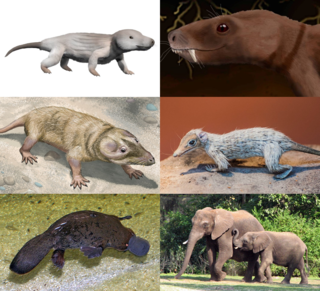
Cynodontia is a clade of eutheriodont therapsids that first appeared in the Late Permian, and extensively diversified after the Permian–Triassic extinction event. Mammals are cynodonts, as are their extinct ancestors and close relatives (Mammaliaformes), having evolved from advanced probainognathian cynodonts during the Late Triassic.

Cynognathus is an extinct genus of large-bodied cynodontian therapsids that lived in the Middle Triassic. It is known from a single species, Cynognathus crateronotus. Cynognathus was a predator closely related to mammals and had a southern hemispheric distribution. Fossils have so far been recovered from South Africa, Argentina, Antarctica, and Namibia.
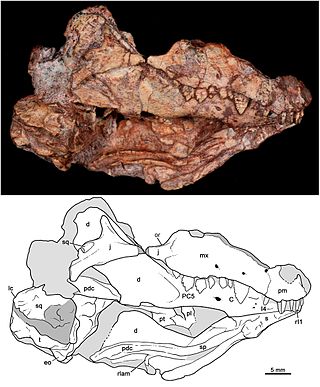
Probainognathidae is an extinct family of insectivorous cynodonts which lived in what is now South America during the Middle to Late Triassic. The family was established by Alfred Romer in 1973 and includes two genera, Probainognathus from the Chañares Formation of Argentina and Bonacynodon from the Dinodontosaurus Assemblage Zone of Brazil. Probainognathids were closely related to the clade Prozostrodontia, which includes mammals and their close relatives.

Ecteninion is an extinct genus of meat-eating cynodonts that lived during the Late Triassic (Carnian) in South America. The type species Ecteninion lunensis was named by R.N. Martinez, C.L. May, and C.A. Forster in 1996. E. lunensis is known from a nearly complete skull of about 11 centimetres (4.3 in) in length. It was found in the Cancha de Bochas Member of the Ischigualasto Formation in the Ischigualasto-Villa Unión Basin in northwestern Argentina. It has been interpreted as a basal eucynodont. The holotype is in the collection of the Universidad Nacional de San Juan.
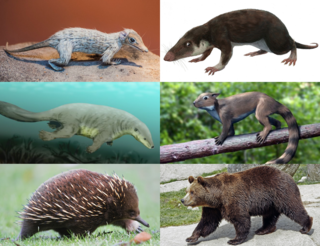
Mammaliaformes is a clade that contains the crown group mammals and their closest extinct relatives; the group radiated from earlier probainognathian cynodonts. It is defined as the clade originating from the most recent common ancestor of Morganucodonta and the crown group mammals; the latter is the clade originating with the most recent common ancestor of extant Monotremata, Marsupialia, and Placentalia. Besides Morganucodonta and the crown group mammals, Mammaliaformes includes Docodonta and Hadrocodium.

Therocephalia is an extinct clade of eutheriodont therapsids from the Permian and Triassic periods. The therocephalians ("beast-heads") are named after their large skulls, which, along with the structure of their teeth, suggest that they were carnivores. Like other non-mammalian synapsids, therocephalians were once described as "mammal-like reptiles". Therocephalia is the group most closely related to the cynodonts, which gave rise to the mammals, and this relationship takes evidence in a variety of skeletal features. Indeed, it had been proposed that cynodonts may have evolved from therocephalians and so that therocephalians as recognised are paraphyletic in relation to cynodonts.

Cynognathia is one of two major clades of cynodonts, the other being Probainognathia. Cynognathians included the large carnivorous genus Cynognathus and the herbivorous or omnivorous gomphodonts such as traversodontids. Cynognathians can be identified by several synapomorphies including a very deep zygomatic arch that extends above the middle of the orbit.
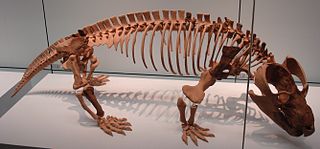
Probainognathia is one of the two major subgroups of the clade Eucynodontia, the other being Cynognathia. The earliest forms were carnivorous and insectivorous, though some groups eventually also evolved herbivorous diets. The earliest and most basal probainognathian is the Middle Triassic (Anisian) aged Lumkuia, from South Africa, though probainognathians would not become prominent until the mid Norian stage of the Late Triassic. Three groups survived the extinction at the end of Triassic: Tritheledontidae and Tritylodontidae, which both survived until the Jurassic—the latter even into the Cretaceous —and Mammaliaformes, which includes the mammals.

Eutherocephalia is an extinct clade of advanced therocephalian therapsids. Eutherocephalians are distinguished from the lycosuchids and scylacosaurids, two early therocephalian families. While lycosuchids and scyalosaurids became extinct by the end of the Permian period, eutherocephalians survived the Permian–Triassic extinction event. The group eventually became extinct in the Middle Triassic.
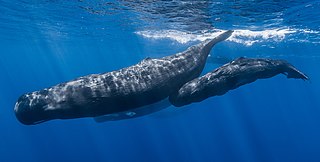
Epicynodontia is a clade of cynodont therapsids that includes most cynodonts, such as galesaurids, thrinaxodontids, and Eucynodontia. It was erected as a stem-based taxon by Hopson and Kitching (2001) and defined as the most inclusive clade containing Mammalia and excluding Procynosuchus, a Late Permian genus that is one of the most basal cynodonts.

Theriognathus is an extinct genus of therocephalian therapsid belonging to the family Whaitsiidae, known from fossils from South Africa, Zambia, and Tanzania. Theriognathus has been dated as existing during the Late Permian. Although Theriognathus means mammal jaw, the lower jaw is actually made up of several bones as seen in modern reptiles, in contrast to mammals. Theriognathus displayed many different reptilian and mammalian characteristics. For example, Theriognathus had canine teeth like mammals, and a secondary palate, multiple bones in the mandible, and a typical reptilian jaw joint, all characteristics of reptiles. It is speculated that Theriognathus was either carnivorous or omnivorous based on its teeth, and was suited to hunting small prey in undergrowth. This synapsid adopted a sleek profile of a mammalian predator, with a narrow snout and around 1 meter long. Theriognathus is represented by 56 specimens in the fossil record.
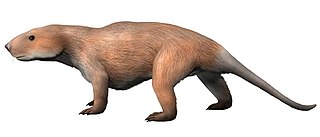
Riograndia is an extinct genus of prozostrodontian cynodonts from the Late Triassic of Brazil. The type and only species is Riograndia guaibensis, named after the State of Rio Grande do Sul and Guaíba Basin, where it was discovered. Remains have been found in the Caturrita Formation of the geopark of Paleorrota. It was a small non-mammalian cynodont, with several advanced features also present in mammals. Several specimens of Riograndia guaibensis have been found in the towns of Candelária and Faxinal do Soturno in the Caturrita Formation. The genus defines the Riograndia Assemblage Zone.

Pachygenelus is an extinct genus of tritheledontid cynodonts. Fossils have been found from the Karoo basin in South Africa and date back to the Early Jurassic.

Lumkuia is an extinct genus of cynodont, fossils of which have been found in the Cynognathus Assemblage Zone of the Beaufort Group in the South African Karoo Basin that date back to the early Middle Triassic. It contains a single species, Lumkuia fuzzi, which was named in 2001 on the basis of the holotype specimen BP/1/2669, which can now be found at the Bernard Price Institute in Johannesburg, South Africa. The genus has been placed in its own family, Lumkuiidae. Lumkuia is not as common as other cynodonts from the same locality such as Diademodon and Trirachodon.
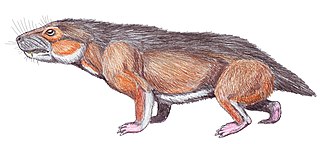
Eutheriodontia is a clade of therapsids which appear during the Middle Permian and which includes therocephalians and cynodonts, this latter group including mammals and related forms.

Prozostrodontia is a clade of cynodonts including mammaliaforms and their closest relatives such as Tritheledontidae and Tritylodontidae. It was erected as a node-based taxon by Liu and Olsen (2010) and defined as the least inclusive clade containing Prozostrodon brasiliensis, Tritylodon langaevus, Pachygenelus monus, and Mus musculus. Prozostrodontia is diagnosed by several characters, including:

Gomphodontia is a clade of cynognathian cynodonts that includes the families Diademodontidae, Trirachodontidae, and Traversodontidae. Gomphodonts are distinguished by wide and closely spaced molar-like postcanine teeth, which are convergent with those of mammals. Other distinguishing characteristics of gomphodonts include deep zygomatic arches, upper postcanines with three or more cusps spanning their widths and lower postcanines with two cusps spanning their widths. They are thought to have been herbivorous or omnivorous. Gomphodonts first appeared in the Early Triassic and became extinct at the end of the Late Triassic. Fossils are known from southern Africa, Argentina and southern Brazil, eastern North America, Europe, China, and Antarctica.

























